Justice Sotomayor recently suggested that the Court, or at least its conservative members, were biased in favor of the Trump Administration. Not only is Justice Sotomayor’s statement a highly unusual public jab at her colleagues, it is demonstrably false.
Justice Sotomayor’s comments piggyback on the liberal media’s hysteria that the replacement of Justice Kennedy with Justice Kavanaugh would transform the Court into a bastion of the right. The New York Times, for example, protested that Justice Kavanaugh’s confirmation would lead to “a solid five-member conservative majority” that likely would restrict access to abortion, expand gun rights, and give religion a greater role in public life. (Oh, the horror.)
But what the liberal media and Justice Sotomayor appear to misunderstand is the judicial philosophies of originalism and textualism. Those philosophies require judges to adhere to the text and original understanding of the Constitution and of federal statutes–they do not allow judges to insert their own personal policy preferences.
In fact, the liberal predictions of a “solidly conservative court,” by which the New York Times no doubt meant a politically solidly conservative court, foundered on statistics from the first term which show that, far from rubber stamping the Trump Administration in tandem, Justices Gorsuch and Kavanaugh have disagreed a lot.
In fact, the so-called liberal justices were in the majority in more five-four decisions than the so-called conservatives by a solid margin—ten to seven. Further, Justices Kavanaugh and Justices Gorsuch, both obviously appointed by President Trump agreed only 70% of the time. According to ScotusBlog, no two justices appointed by the same president have disagreed more in their first term together since the 1960s. Justices Sonia Sotomayor and Elena Kagan, both appointed by President Barack Obama, agreed more than 96% of the time in their first term.
Further, while Justice Sotomayor protests the number of emergency stays sought by the government, she neglects to mention that many of these stay requests came after the issuance of a nationwide injunction–the controversial judicial maneuver by which a single federal judge can block democratically enacted legislation with the stroke of her pen. Thus any sort of “leapfrogging” of the lower courts is often a necessary step to prevent broad judicial overreach


